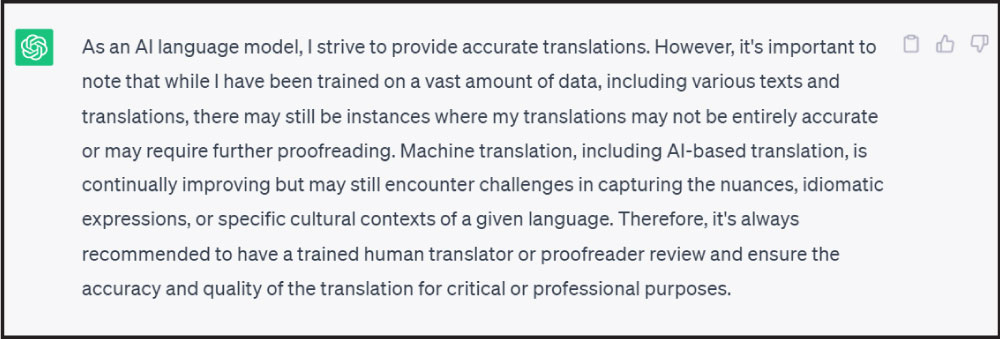ChatGPT’s translation strengths & limitations
|
Font size:
Contemplating whether ChatGPT could be your new translation and localization companion? Amongst the various hot machine translation options available in the market, including Google Translate, Microsoft Translate and DeepL, this tool has sparked widespread attention for its translation capabilities.
But are ChatGPT’s translations any good? And how does it fair compared to its almighty competitors? Let’s dive right in.
Is ChatGPT good at translation?
In an effort to gauge ChatGPT’s translation quality and determine its competitiveness, Microsoft, Intento, and Tencent compared the translation output of GPT models with that of machine translation engines. Turns out, GPT-3’s translation quality can be decent… but that’s not always the case. Their results found that GPT’s ability to generate translations accurately and consistently is confined to a select few languages, such as English, German, Spanish and Italian.
However, even for those languages, GPT could not produce translations of high enough quality to match the output of popular machine translation tools. What’s more, Intento found that ChatGPT performed significantly slower in comparison.
So does this mean that you should simply ditch it as a potential translation tool? We don’t think so.
ChatGPT vs machine translation engines
Since ChatGPT’s resources for different languages are scarce, when comparing the AI against Google Translate, Microsoft Translate or DeepL, it evidently has a long way to go. But although it can’t replace them just yet, it does have an edge than no other machine translation engine seems to have.
Here’s the kicker: Translation tools may be able to provide translations more promptly and accurately, but their usefulness ends there. ChatGPT, on the other hand, is far more versatile and offers loads of customization options. Thanks to its interactive nature, the tool enables you to experiment with various prompts to tailor the translation to your specific needs. For example, you can specify your desired style or tone to better align your content with its intended purpose.
Let’s say you are translating the English sentence “Thank you for your inquiry. We appreciate your interest in our products.” into German without providing additional context. In this case, GhatGPT will translate it as “Vielen Dank für Ihre Anfrage. Wir schätzen Ihr Interesse an unseren Produkten.”
But if you then request for the translation to convey a warmer tone, you’ll get a very different response: “Herzlichen Dank für Ihre Anfrage. Wir sind sehr erfreut über Ihr Interesse an unseren Produkten.” The use of the phrase “sehr erfreut” (which translates to “very pleased”) in this sentence conveys a higher level of enthusiasm and excitement.
Here we have two different interpretations to one text and the ability to choose which one best suits the context in which that sentence will appear. With Google Translate, by contrast, we’d only have one interpretation we can work with.
And ChatGPT’s advantage is quite significant. That’s because a translation’s success lies not only in accurately conveying the words, but also in capturing the intended meaning, cultural nuance and context behind the message. Since OpenAI considers the broader context based on the instructions that it’s given, it offers a compelling advantage when stacked against traditional translation engines.
Can you use ChatGPT instead of human translators?
These kinds of questions always take us back to the long-standing debate of whether we should use AI translation instead of human translators. And the answer to that is always the same: well, it depends.
For simple text translation, machine translation might fit the purpose. However, even in such cases, you can’t rely solely on AI. As the possibility of error is still there, you will always need a trained translator/proof-reader to judge the quality and accuracy of the translation and rectify any potential errors prior to release. For example, when using ChatGPT, a translator would need to compare the translations generated and then refine the output to achieve the desired translation quality. In the words of the AI:

Then, there also cases where machine translation is a big no-no. When it comes to complex texts, such as for the medical or legal industries, even a minor error or mistranslation could have significant consequences. The specialized terminology, technical jargon and intricate concepts involved in medical and legal texts demand the expertise and knowledge of human translators who are trained in these specific areas.
Finally, ChatGPT is not appropriate for companies that handle sensitive information. As the data processed by AI models can potentially pass through multiple servers and systems, there is a risk that sensitive information or content could be exposed or accessed by unauthorized parties. Therefore, such companies should exercise a great degree of caution while using AI technology.
Human quality and technology
In conclusion, it’d be unwise to place your bets on ChatGPT’s translations. Remember: It only takes one bad translation to deliver damage to your brand, and you should play it safe.
Regardless, machine translation and OpenAI’s usefulness are undeniable. AI tools can make translators’ work significantly easier, allowing companies to release more content and expand their international reach faster. The key phrase here is ‘human intervention’. Optimal results can only be achieved by combining the strengths of technology with human expertise.
With Pangea’s professional translation services, you get the best of both. With over 900+ translators and advanced translation tech in our arsenal, the quality of your translations is guaranteed. Get in touch to find out more!




